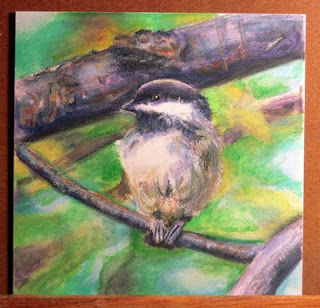One of my readers asked me to do a more in-depth description of the process I used to create my latest painting "Chickadee" in Inktense pencils and Neocolor II crayons. I hope that by sharing my process here I will encourage others to try out this fun technique too!
Picking tools
I have been fascinated by Inktense pencils since I first heard about them. I have been most pleased to see how well these ink pencils integrate seamlessly into ink artwork. Unfortunately, some of the Inktense colors aren’t very lightfast and to avoid fading I decided to choose the colors for my piece based on lightfastness ratings of 6 and above (on a scale of 1-8, 8 being the most lightfast.)
I have been taking an interest in water-soluble pencils and crayons recently and was curious to try using the Caran D’ache Neocolor II crayons in a fine art piece.
On one of my trips to Dick Blick's a while ago I picked up a small piece (8” x 8”) of Aquabord to experiment with. I liked the idea of using it here as the surface is rather rough and I thought it would work well to show the roughness of the tree bark in my picture.
Picking a palette
In starting a new piece my first step is always to choose a palette. Although I may add additional colors later on, I think it's best to do some planning before you start. Flying blind with color can lead to some awkward color passages and disharmonies later on.
I use hole-punched pieces of white watercolor paper (nice and heavy) to match little pieces of color in my reference photo with the Inktense and Neocolor II swatches in my swatch book.
Once the palette is chosen I'm ready to start the piece. Here is a look at my workspace with palette swatches, brushes, a sponge, and q-tips for applying and softening color, pencil sharpener, Inktense pencils (in cup), mechanical pencil, and some of my Neocolor II crayons laid out and ready to go.
Here is the reference photo I chose to work with in this piece.
I used graphite transfer paper to transfer the basic image shapes to the Aquabord.
The Painting
To begin the painting I laid down color with Inktense pencils to create the out-of-focus background. After applying the color I smoothed it with q-tips wet with a moderate amount of water. The Inktense pencils create very bright colors that will be enhanced and softened by Neocolor crayons later on.
Here is the Chickadee with Neocolor II
crayons added over the Inktense pencils in the background. Fairly opaque in nature, they helped create more variation and richness to the background as a whole. At this stage the background is nearly complete.
Next I began working on the darkest darks in the tree branches in the middle ground with Inktense pencils. I have also colored the bird’s eye for tonal reference. The eye will remain the darkest dark in the entire piece.
I have developed the branches a bit farther here and added a tiny bit of work on the bird itself. At this stage the colors you see in the middle and foreground are still in Inktense only. I have not yet started adding the Neocolor
crayons to the branches.
Here we see the main branch completed after adding several layers of Neocolor II crayons. I have also started adding Neocolor to the other branches.
With more detail (Neocolor II) added to the other two major branches and a bit of color (Inktense) added to the bird, the painting is beginning to come together.
The piece is almost done now. Just the final details and some smoothing of the color is left to do. At this stage I like to leave the piece for a few days so that I can contemplate what still needs to be done after a break. Sometimes, I’ll turn the painting upside-down and look at it next to the reference photo (also upside-down) to see if the shapes and colors are matching well. Turning a piece upside-down can help remove your ego from your thought process and simply analyze the shapes and colors for accuracy.
 |
Chickadee 8" x 8"
Neocolor II crayons and Inktense pencils on Aquabord |
Well, here it is! The finished Chickadee painting. I am most pleased by how this new medium worked out for me. It was satisfying in both a tactile and a visual way. High marks for enjoyment!
Here are some close-up images from the painting:
 |
| Close-up of the main branch |
 |
| Close-up of the bird |
I hope that this tutorial has been helpful and even inspiring. Creating this painting has certainly been the most fun I’ve had using crayons since the second grade! Why not try this technique yourself? If you do, I'd love to hear from you. And don't forget to send me a link too so I can see what you've created! If you liked seeing my step-by-step process here please let me know and I'll post more how-to's in this style in the future. :-)

































